Enab Baladi Investigation Team
The “red line”, “the cause of international action” and “the most hostile instrument of criminality,” through these words the United States and its European allies have been addressing international forums to threaten the regime of Bashar al-Assad in case he used chemical weapons or dared to subject the Syrians to these most deadly weapons.
International threats have been brought to the ground amid the recent massacre in the city of Douma, which took the life of nearly 100 people and closed the last files of the capital’s vicinity for al-Assad regime’s favour. On Saturday morning, April 14, Damascus witnessed a tripartite military attack which was carried out by the USA, France, and Britain, and which targeted a number of the regime’s military headquarters in the vicinity of Damascus.
However, again al-Assad has not been affected by this attack, neither materially nor politically. On the morning of the same day al-Assad showed up at his palace, and mobilized his media outlets to celebrate “victory over those who tried to transgress national sovereignty.”
Although the consequences of the Western military move may make a difference at the political level against Russia, on the scale of Sochi and Astana, and at the level of the international diplomatic crisis with Moscow, the strike seemed “limited” compared to the Syrians’ expectations. Likewise, the international censorship mechanisms, which are supposed to hold al-Assad back are not even capable of condemning or hold him accountable.
With Russian support
The regime is using chemical weapons to its credit
Despite the existence of international reports which prove the Syrian regime’s use of chemical weapons, al-Assad tried to turn the file into his favor. Russia has assisted him with that, amid the absence of UN regulations, which are supposed to hold back the killing machine using poison gas and other weapons. As a result of its unrestricted movements, the regime is even chairing a conference on chemical disarmament in the United Nations.
Before the chemical attacks, the representatives of the Syrian regime continued to pave the ground in international forums for what they described as “fake anecdotes” concocted by the opposition factions with the participation of the “civil defence.” The same accusation was made by the Russian Foreign Ministry prior to the recent attack on Douma.
Inviting OPCW to investigate in Douma
For the first time, the Syrian Foreign Ministry officially invited the Organization for the Prohibition of Chemical Weapons (OPCW) to open an investigation into the bombing of Douma.
The Syrian news agency (SANA) quoted a source at the foreign ministry, on Tuesday, 10 April, stressing that al-Assad’s regime will cooperate with the international organization to uncover the “allegations” about the use of chemical weapons..
Russian Foreign Minister Sergey Lavrov said from Moscow on Friday, 13 April, that Russia has conclusive evidence that the alleged chemical attack in Douma “was a play, in which foreign intelligence has participated, specifically state intelligence seeking to be in the first ranks of the anti-Russian campaign.”
At the UN Security Council session on international peace and security, UN Secretary-General Antonio Guterres said that “the Syrian government has bound itself to facilitating the task of chemical weapons investigators,” who arrived from Beirut to Damascus. Guterres expressed his “anger” over the repeated use of chemical weapons without the conviction of any particular party.
In the aftermath of the attack, Russia repeatedly showed interest in revealing the truth, denying hundreds of photographs which depicted civilians, including children and women, bearing the marks of suffocation with poisonous substances. Russia pointed out its experts had arrived in Douma a day after the alleged attack and examined soil samples and shrapnel, which proved to be “free of nerve gas and chlorine, “according to Russian Ministry of defence.
In an interview with Enab Baladi, the official spokesman of the High Negotiation Committee, Dr. Yahya al-Aridi, stated that the regime cannot circumvent the chemical weapons file, “because it has been already proved and the regime was officially recognized by many countries of the world as the perpetrator of war crimes.”
He considered that “even if the regime was not subject to a strike from the US or other countries, it will not be rehabilitated to assume any future responsibility in Syria.” He added that “the regime is officially falling after the moral decay it has witnessed over the past years.”
Al-Aridi spoke about the Russian “confusion” and statement disparities concerning the file. He pointed out that the attempt of the regime, which is backed up by Russia the permanent member of the Security Council, to win the file to their favour, “does not affect the international resolutions.” In this regard he referred back to the American, French, and British strike on the Syrian regime’s headquarters.
|
The Conference on Disarmament was established in 1979 after a special session of the United Nations General Assembly. Syria is represented in this conference by Ambassador Hussam Eddine Aala, the permanent representative of Syria to the United Nations in Geneva. The Conference discusses the Biological Weapons Convention, which prohibited the development, production, and stockpiling such weapons and the need to destroy them. The Conference also discusses the Convention which prohibits military or any hostile use of environmental modification techniques and the Comprehensive Nuclear Test Ban Treaty. |
Syria is chairing the United Nations Disarmament Forum
Aside from the Security Council’s discussions on chemical weapons, Syria has been set up as the chair member of the United Nations Disarmament Forum on chemical and nuclear weapons, which is being attended by 65 countries around the world.
The Geneva-based Un Watch, an independent organization that monitors the work of the United Nations, reported on its official website that Syria will head the forum in May, calling on America and the European Union to object and remove their ambassadors from the conference amid demands from the UN Secretary-General to look into the matter.
“It is illogical for al-Assad to run the next forum at a UN conference on nuclear and chemical disarmament,” said Hillel Neuer, chief executive of Un Watch via his personal Twitter account, on Monday (April 9th).
Neuer likened the Syrian regime chairing the forum, which is being held for four weeks between May 28 and June 24, as “an armed rapist being put in charge of a women’s shelter.”
The organization stated that it is intending to arrange protests outside the UN hall, in support for the Syrian who were victimized by the regime’s chemical weapons’ attacks. Meanwhile the chief executive of the organization stated that “al-Assad’s violation of the chemical weapons deal was the most serious breach of the agreement since it has been signed 20 years ago.”
He also pointed out that the fact that the regime is heading the forum, “is shocking to the conscience of humanity.” He stated that this “undermines the credibility of the United Nations and sends the worst messages ever.” Neuer called on the USA, Britain, France, Germany, and all Member States and observers to react by refusing to send ambassadors to the conference. He compared this to the incident of the withdrawal of America and Canada when Iran was heading the Conference in 2013, stressing that “we must do it again.”
According to al-Aridi, the regime’s chairing of the conference “hinders useful and appropriate discussions.” He added that “the chair of the conference must not be the owner or user of chemical weapons.”
The four most prominent Chemical Weapons attacks before Douma
In addition to the difficulty of issuing an international resolution to put an end to al-Assad’s use of chemical weapons, the centres documenting the violations are facing difficulty in determining the precise number of victims of such attacks. It is difficult to limit the number of times it was used, from 2013 until the last attack.
Otaybah Attack, February 2013
Otaybah attack was the first event in which chemical weapons were used on opposition held area in eastern Damascus. The attack took the lives of 14 people, including 12 civilians and two of the Free Army’s fighters.
The attack coincided with an operation launched by six factions of the Syrian opposition on the military base of the “16 Regiment” in western military airport of al-Dumayr.
However, the attack did not receive attention from Arab and international media outlets due to the scarcity of information coming from al-Marj in Eastern Ghouta.
Khan al-Asal Attack, March 20, 2013
Al-Assad and opposition forces have reciprocally held each other responsible for the chemical attack on the town of Khan al-Asal in the western countryside of Aleppo Governorate in northern Syria, which killed 123 people, the majority of whom were civilians, in conjunction with the opposition’s attack on the region to take control over it.
The official media accused the opposition of the chemical attack, while the opposition denied it.
The UN team of independent investigators, headed by the Brazilian Paulo Pinheiro, pointed out that the chemicals used in the suburb of Ghouta in Damascus and in Khan al-Asal near Aleppo have “the same idiosyncratic features.”
On March 4, 2014, Reuters news agency quoted a UN report as saying: “The chemical weapons used in two incidents are apparently originated from Syrian army’s stocks.”
Ghouta attack, August 21, 2013
Ghouta attack has been described as “the worst attack over a quarter of a century.” During this attack, at least 1,500 civilians were killed by the nerve-damaging Sarin gas on the two cities of Zamalka and Ein Tarma in Ghouta, in the east of the capital Damascus.
Al-Assad’s forces targeted the cities with 13 missiles loaded with this poisonous gas.
According to figures by medical centres, at least 5,000 people were affected by the attacks.
Khan Shaykhun attack, April 4, 2017
The poisonous gases attack on the town of Khan Shaykhun in Idlib Governorate has caused the death of 100 people and injured more than 400 people.
According to the National Coalition for Syrian Revolutionary and Opposition Forces, the regime’s warplanes used missiles loaded with poisonous chemical gases with resulted symptoms similar to those of the sarin gas.
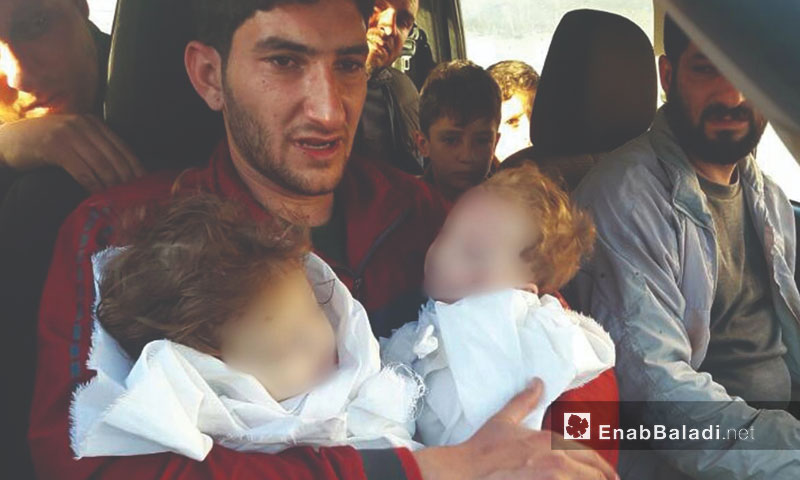
An attack survivor who lost all of his family members in the chemical bombing of the town of Khan Shaykhun in the countryside of Idlib – April 2017 (Archive of Enab Baladi)
Where does al-Assad hide his chemical weapons?
There has been unclear information about the size and whereabouts of the Syrian regime’s chemical weapons arsenal. Even the regime has repeatedly denied possession of any chemical weapons, despite US and Israeli reports that state it has the world’s largest chemical weapons arsenal that had been developed for 40 years, according to what the Deputy Chief of Israeli General Staff, General Yair Naveh, sated in June 2012. The spokesman for the regime’s Ministry of Foreign Affairs at the time, Jihad Makdissi, had then announced that “Syria will not use any chemical or bacterial weapons only if subjected to an external attack.” This was the first official admission of the regime’s possession of chemical weapons.
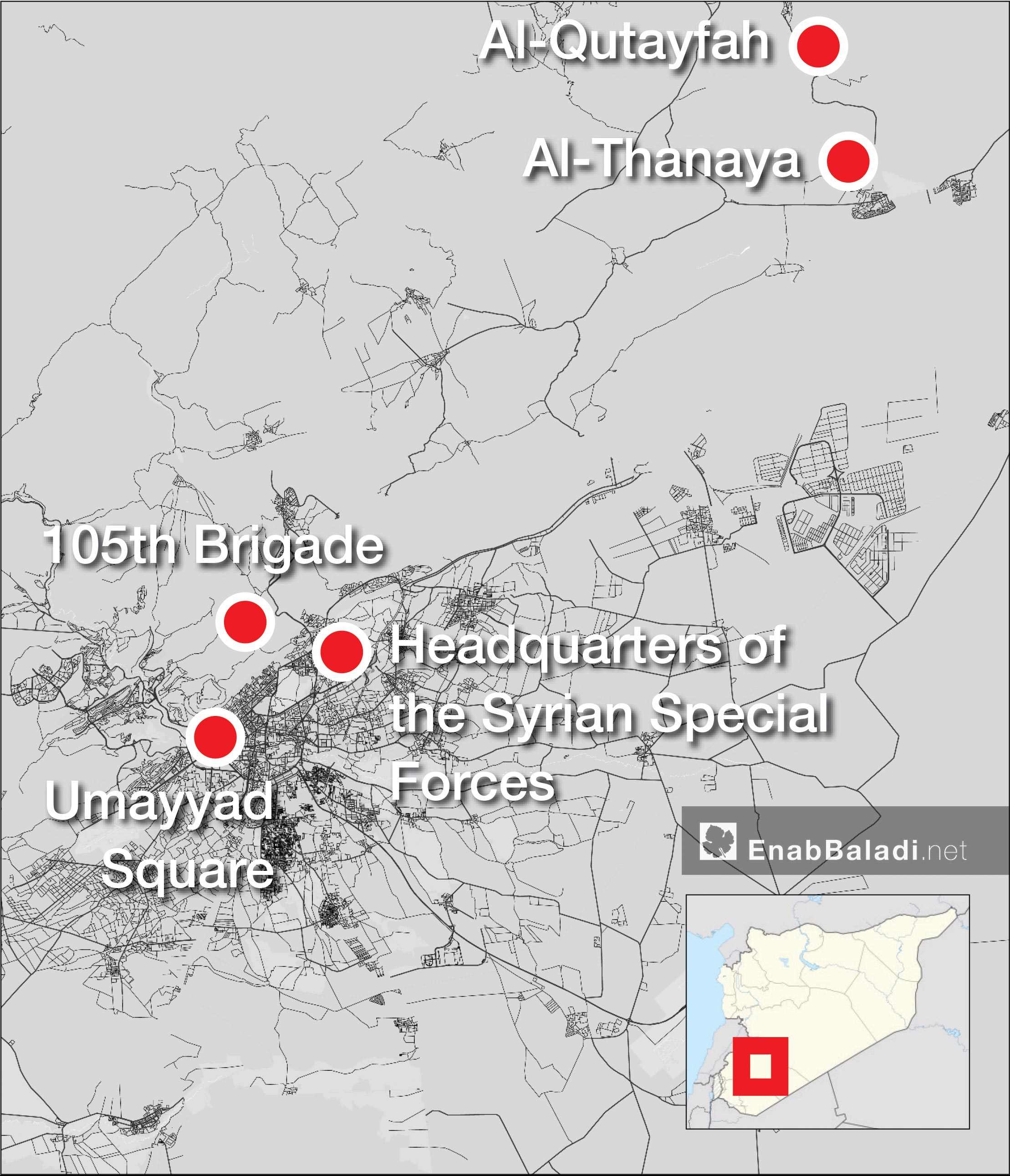
A map showing the locations where al-Assad is hiding his chemical weapons in Damascus and its countryside (Enab Baladi)
The Syrian regime has made its best to keep the chemical weapons system out of sight. However, after bombing Eastern Ghouta with chemical weapons in 2013, and agreeing to hand over its arsenal under a US-Russian deal, the regime announced the existence of 23 storage locations that are extended over 240 miles, with 1,300 tons of chemicals, in addition to the existence of more than 100 missile warheads, most of which are Scud missiles.
Nevertheless, the regime did not fully dispose its chemical arsenal, kept a part of it, and did not announce its secret storing location. This has been revealed through its bombing of several areas after announcing the completion of the destruction of the arsenal.
Brigadier General Ahmed Berri, the Chief of Staff of the Free Syrian Army, had previously explained to Enab Baladi that the Syrian regime owns locations to manufacture toxic materials in the mountain of Taqsis in the southern countryside of Hama, as well as defence laboratories in the area of as-Safira in the southeast of Aleppo, as along with another location it described as “secret” in Rif Dimashq.
In an exclusive report in 2015, Al Jazeera TV quoted a senior leader in the Republican Guard of al-Assad’s forces, whose name was not mentioned, as saying that the regime had hidden large quantities of chemical weapons far more than those it has handed over to the international community.
The officer explained that he knows five secret locations, the first of which is 11 underground floors located under the command of the air force in the centre of Damascus to the east of the Umayyad Square, and extends under the leadership of the General Staff, Officers Club, and the former Meridien Hotel.
The second location is at the headquarters of the 105th Brigade on the western slope of Mount Qasioun. It is deeply extended under the mountain and is likely to be the largest store of chemical weapons. The third location, according to the officer, is at the first large turn on the Damascus-Aleppo International highway in the area of al-Thanaya after the dwellings of Adra on the left side in front of a highway police station.
The fourth location is a chemical weapons’ store that is located on the Damascus-Aleppo highway on the right of the first turn after the area of al-Qutayfah. There is a small orchard with a house in the middle, which constitutes the entrance to the store.
Local and international media indicated that there are chemical weapons at the Syrian Scientific Studies and Research Centre in Jamraya in Barzeh neighbourhood of Damascus, in addition to Unit 416, which is located in the south of the town of as-Safira in the countryside of Aleppo, and Unit 418, which is located in the east of the town of Furqlus on the road of Palmyra in the east of Homs.
US-Russian conflict over chemical weapons investigation committees
The UN Security Council Resolution 2235, which was issued in August 2015, has marked a major turning point in the Syrian chemical weapons matter, when the Council’s member states agreed to form a joint investigation mechanism between the United Nations and the Organization for the Prohibition of Chemical Weapons (OPCW) to investigate the chemical attacks in Syria, and to identify the parties responsible for such attacks.
The Committee was formed after a draft resolution that the United States submitted to the Security Council, under which it designated the work of the Committee for a period of one year, which can be extendable.
During the first year of its work, the aforementioned committee had to investigate nine chemical attacks on seven areas inside Syrian territories. However, it has only managed to identify the perpetrators of four attacks. It has held the Syrian regime responsible for three attacks while ISIS was held accountable for one attack.
In this context, the Independent International Commission of Inquiry on the Syrian Arab Republic has issued several reports, most notably the report that held the Syrian regime responsible for a chemical attack on the town of Qminas in Idlib Governorate, on 16 March 2015. It has also concluded that al-Assad forces were responsible for two similar chlorine attacks on Tell Mannas in the countryside of Idlib, on 21 April 2014, and Sarmin in the countryside of Idlib on 16 March 2015.
Investigators have concluded that ISIS used mustard gas in Mare’ in Aleppo Governorate, on 21 August 2015.
Despite the calls that have been raised in the Security Council to hold the responsible parties accountable, these reports have remained in the context of documentation and have not yet been elaborated in the framework of legal accountability because of Russian criticism, which has described the Commission’s reports as “lacking integrity”.
The report that overthrew the Commission of Inquiry
After the end of the first year of the work of the Joint Commission of Inquiry, the UN Security Council passed Resolution N° 2319 in November 2016, to extend the work of the Commission of Inquiry for another extendable period of one year, ending in November 2017.
However, the most prominent report of the Commission on the charge of Khan Shaykhun massacre, in 2017, was the report that ended its mission because of Russia’s rejection of accusations by investigators to the Syrian regime of being responsible for the massacre.
The Commission concluded that al-Assad forces were responsible for the use of Sarin gas during an attack on Khan Shaykhun in April 2017, which killed 87 people and injured 400 others.
However, Moscow, al-Assad’s ally in the Security Council, rejected the report, and said that it was “not based on facts,” to start a US-Russian war in the corridors of the Council on the extension of the work of the Joint Inquiry Commission for a third period.
In this context, Russia used “veto” power twice within 24 hours, in meetings of the Security Council at the end of 2017 to renew the work of the Commission of Inquiry.
At the time, Washington submitted a draft resolution to extend the work of the commission with the same mechanism of work and without change. However, Moscow vetoed the draft resolution and submitted another draft, which stipulated changing the mechanism of work of the committee to approve the renewal of the mandate, but the Russian project was at that time met with a US veto.
Russia has also rejected a Japanese draft resolution which extends the commission’s mandate 30 days, after failing to extend it for a full year. The commission officially announced its suspension on November 20, 2017.
More than four months after the suspension of the Commission of inquiry work, specifically when the Syrian regime was accused of using toxic gases in the city of Douma in eastern Ghouta, on April 7, Moscow tried to prevent international condemnation of the incident by submitting two draft resolutions to the Security Council to establish a new investigative mechanism according to Russian conditions, but the two projects failed to get nine votes, the minimum number of votes required to adopt any draft resolution in the Council.
On the other hand, Russia used a veto against a US draft resolution that sought an investigation into the recent chemical attacks on Douma.
UN resolutions not yet met with Russia’s “veto”, with regard to chemical attacks in Syria (Time Line).
Despite the use of the veto 12 times, since the beginning of the Syrian conflict, six of which were used against draft resolutions which condemned the Syrian regime of the use of chemical weapons, the Security Council was able to unanimously pass resolutions, which the Russian “veto” was unable to prevent, but Moscow conditions were taken into account then.
The most prominent of these decisions were taken between 2013 and 2017, the most important of which are:
Resolution No. 2118 (27 September 2013)
The UN Security Council issued Resolution 2118 in September 2013, after the Syrian regime used toxic gases in eastern Ghouta, which killed more than 1,100 people and injured 5,000 others in an attack described as “the most hostile” since the beginning of the Syrian conflict.
At the time, several countries threatened to launch a military strike against the Syrian regime. However, the Syrian regime, under pressure from Russia, ratified the Chemical Weapons Convention (CWC), and pledged to comply with Security Council Resolution 2118.
The most prominent items of the resolution include:
– Removing and destroying the Syrian regime chemical arsenal.
– Syrian regime’s compliance with the Chemical Weapons Convention.
– To punish the Syrian regime if chemical weapons are used again under Chapter VII of the United Nations Charter.
– To allow international inspectors to visit and investigate any area in Syria.
Resolution 2209 (6 March 2015)
On 6 March 2015, the UN Security Council adopted a resolution which condemns any form of chemical use in Syria by the parties to the conflict.
The most prominent items of the resolution include:
– Condemning the use of toxic gas in Syria.
– Stressing that the Syrian regime does not use, manufacture, or store chemical weapons.
– Stressing that all parties to the conflict do not use chemical weapons.
– Holding accountable any party responsible for the use of toxic gases in Syria.
– Abiding by Resolution No. 2118.
Resolution 2235 (7 August 2015)
On August 7, 2015, the United Nations Security Council passed a US draft resolution 2235 which provides for the establishment of a joint investigation mechanism between the United Nations and the Organization for the Prohibition of Chemical Weapons (OPCW) following several reports about the use of Chlorine gas by the Syrian regime, bypassing previous Security Council resolutions.
The most prominent items of the resolution include:
– Establishment of a joint investigation commission for one extendable year.
– The mission of the committee is to determine which party is responsible for the use of chemicals in Syria, but without the eligibility to hold any party accountable.
– To inform the Security Council of all reports issued by the Commission.
– Condemning the use of chemical weapons by the parties to the conflict in Syria.
Resolution “2314” (31 October 2016)
Resolution 2314 provides for the extension of the functions of the Joint Investigation Commission for a short period, after which a unanimous decision is taken to extend its mandate for a second term. The most prominent items of the resolution include:
– Extension of the work of the Joint Investigation Commission for three weeks.
– Expanding the functions of the joint commission in the identification of chemical users in Syria.
Resolution 2319 (17 November 2016)
It is decided to extend the work of the Joint Commission of Inquiry in Syria for a second term, in accordance with UN Security Council resolution 2319.
The resolution highlighted:
– Extension of the work of the Joint Investigation Commission for a further year that can be extended.
– Condemning the use of chemical weapons in Syria.
– Stressing that the parties to the conflict do not use chemicals.
The year 2017 did not see any Security Council resolutions regarding the use of chemical weapons in Syria. Russia used the veto twice to thwart the work of the International Commission of Inquiry, which concluded in one of its reports the responsibility of the Syrian regime for the chemical use in Khan Shaykhun massacre on 4 April 2017.
if you think the article contain wrong information or you have additional details Send Correction
النسخة العربية من المقال
-
Follow us :











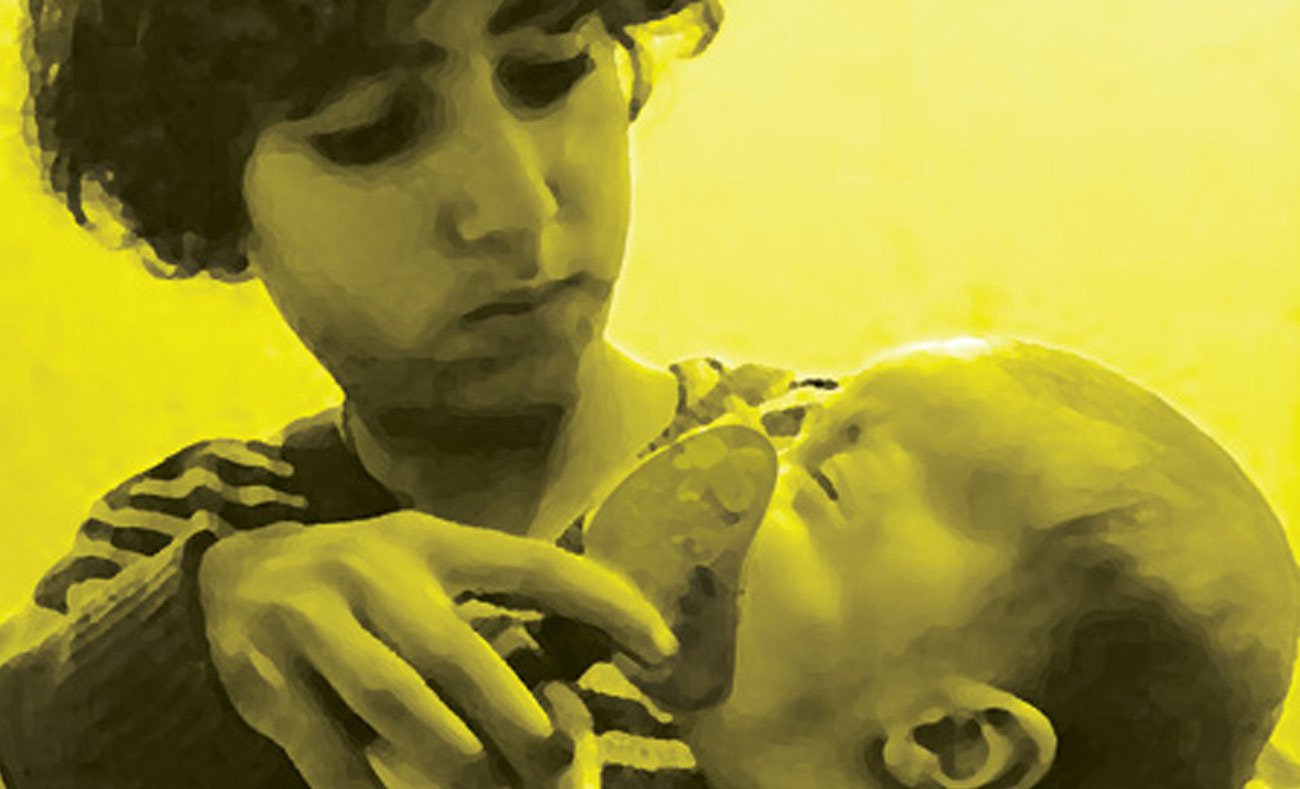






 A
A
A
A
A
A

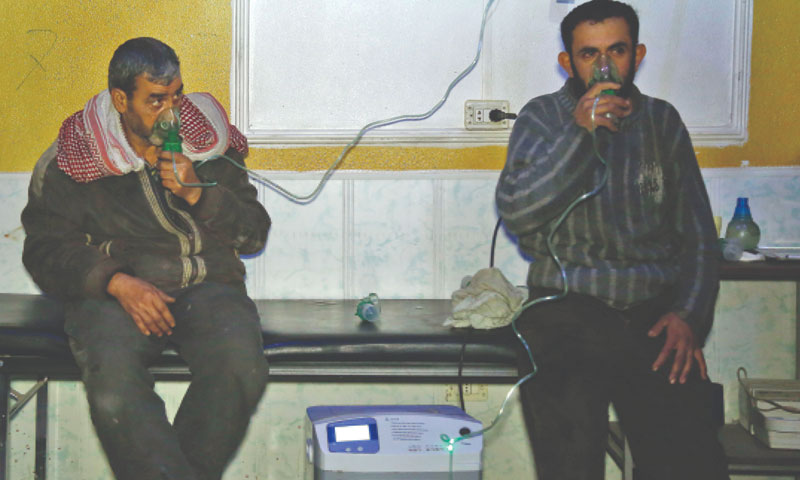
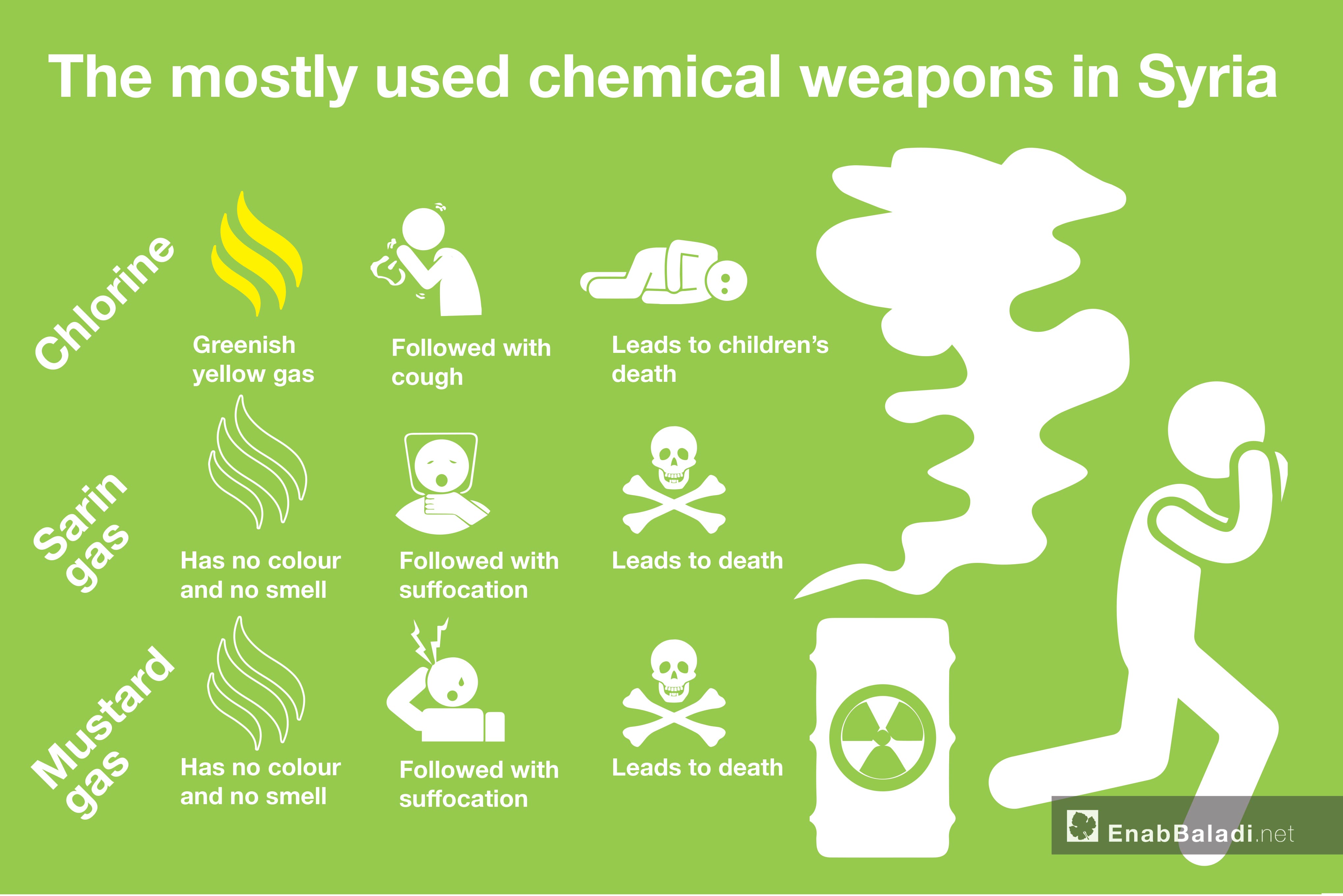



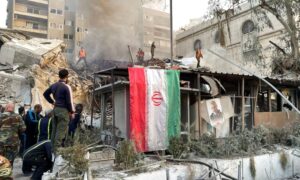

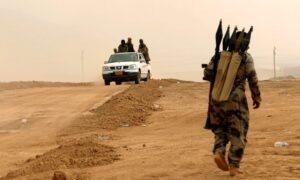
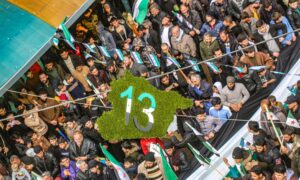
 More In-Depth
More In-Depth